

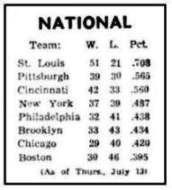
VOL. II NO. 49 REG NO. L5015 DELHI, THURSDAY AUGUST 17, 1944.
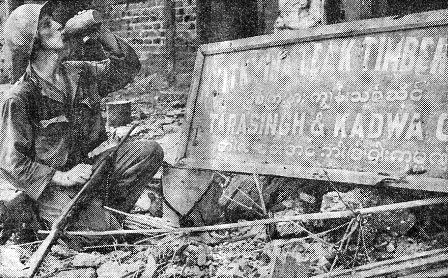 Sgt. John Busaites pauses by the Myitkyina Teak Lumber Co. in the seventh block of the town. Chinese often asked the former baseball player to throw grenades for them.
Sgt. John Busaites pauses by the Myitkyina Teak Lumber Co. in the seventh block of the town. Chinese often asked the former baseball player to throw grenades for them.
|
For Key Position
Myitkyina, prize plum of North Burma, appeared to be ours for the picking May 17, when Merrill's Marauders and their Chinese allies stormed out of the hills and seized adjacent Myitkyina Airstrip. But when the Japanese position finally fell last week, 78 savage days and nights of fighting had been written into history. What many observers had failed to assess was the stamina drained from the Sino-American forces during their fabulous 21-day march over the jungled, 6,000-foot Kumon Range. Nor the obvious fact that all the task force had to fight with at the outset was principally what men could carry on their own backs. Before fresh troops and supplies could be flown to the airstrip to capitalize on its capture, the Japs throughout the area drew into the vitals of Myitkyina, dug in with infinite cunning and waited for a death they realized was certain but which they were prepared to make as costly as possible. The monsoon which flooded the battle area helped them, too, as rain and mud always favor a defending force. But gradually the Allied ring tightened around the besieged garrison until finally, last week, the last of an estimated 3,650 Japs met his reward - and the prize was ours. The pictures which appear here were taken by Army Signal Corps photographers during the dying stages of the campaign.
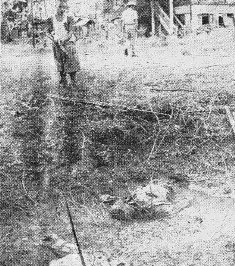 Dead defenders of the town lie grotesquely sprawled at bottom of positions they were ordered to defend to the death.
Dead defenders of the town lie grotesquely sprawled at bottom of positions they were ordered to defend to the death.
|
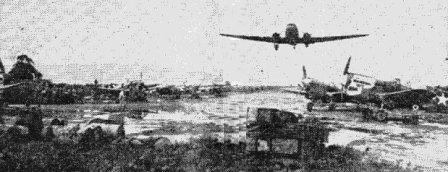 Capture of the Myitkyina Airstrip was one of the important factors in the siege. It was used by a P-40 fighter outfit
and by transports bringing in reinforcements and supplies.
Capture of the Myitkyina Airstrip was one of the important factors in the siege. It was used by a P-40 fighter outfit
and by transports bringing in reinforcements and supplies.
 Ox-carts carry wounded from the front and return with rations and ammunition to the edge of the town. C-47 transport in foreground was wrecked early in campaign.
Ox-carts carry wounded from the front and return with rations and ammunition to the edge of the town. C-47 transport in foreground was wrecked early in campaign.
|
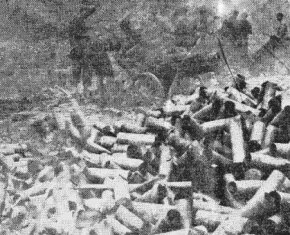 Brass in foreground represents nine hours of 75mm pack howitzer firing in support of attacking infantry.
Brass in foreground represents nine hours of 75mm pack howitzer firing in support of attacking infantry.
|
 A Yank sniper uses a second-story window to advantage. This house earlier received a direct hit by mortar shell.
A Yank sniper uses a second-story window to advantage. This house earlier received a direct hit by mortar shell.
|
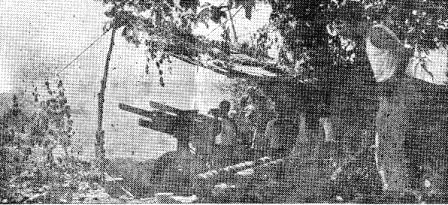 An American-trained Chinese crew pours explosives into battered Myitkyina with its 105mm howitzer. The range of this particular gun was set at about 2,000 yards.
An American-trained Chinese crew pours explosives into battered Myitkyina with its 105mm howitzer. The range of this particular gun was set at about 2,000 yards.
|
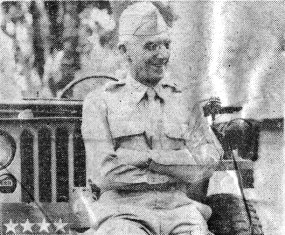
Uncle Joe Was "Elected" |
STILWELL PINS ON STARS
WITHOUT CEREMONY
Joseph W. Stilwell, visiting languorous Ceylon after months of sloughing through the jungle with his polyglot troops in Burma, pinned four stars on his collar one morning last week. As simply as that, without the ceremony he detests. Uncle Joe acknowledged confirmation by the Senate of President Roosevelt's recommendation of his promotion to full general. A week before learning the news, the CBI Commander had quipped characteristically:
"So, I'm nominated. How do you think I'll do in the election?"
In confirming Stilwell's promotion, a spokesman for the Military Affairs Committee said, "The general is a remarkable man to have endured what he has in Burma."
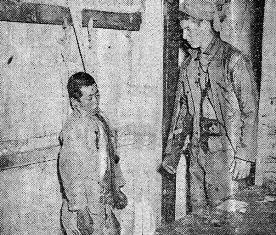 Some Japs in Myitkyina surrendered, but others, like this one, preferred self-inflicted death. Pvt. Thomas J. McCormick, Combat Engineer Infantryman, inspects the body.
Some Japs in Myitkyina surrendered, but others, like this one, preferred self-inflicted death. Pvt. Thomas J. McCormick, Combat Engineer Infantryman, inspects the body.
|
BRITISH TROOPS PUSH EAST TO CHINDWIN
KANDY - British 14th Army troops are pushing east to the Chindwin from the Kabaw Valley in pursuit of retreating Jap elements, while other units are hitting south down the Tiddim Road towards the Burma frontier.
Other British elements are operating in the rear of the remainder of the Jap Expeditionary Force that crossed the Chindwin into Manipur in March. These troops have cut the communication lines that were supplying the enemy in the Chin Hills.
The British have found the Tiddim Road to be lightly held and nature is proving to be a bigger obstacle than the Japs. Landslides and floods are holding up their progress.
British observers say that of the 33rd, 31st and 15th Japanese Divisions which invaded Manipur only the 33rd remains a cohesive unit. This division has also been badly cut up.
Stilwell Pushes Toward Bhamo From Myitkyina
NORTH BURMA - The Allied conquest of North Burma is this week again on the move, even while Gen. Joseph W. Stilwell's men are clearing up the debris of conquered Myitkyina.
Chinese infantry and Kachin levies, under Stilwell's command, pushed south along the Myitkyina-Bhamo road for 13 miles, taking the village of Kazu without mention of Japanese opposition, a factor taken to indicate that the Japs are in steady retreat.
Monsoon weather, now at its worst, has rendered most Burma roads impassable. The Mogaung-Mandalay railway is flooded, many places being under two or three feet of water. However, Stilwell is not only utilizing air transport to whip the Japs but is also employing pontoon engineers to move supplies and men down the flooded Mogaung River.
A Southeast Asia Command communiqu reports that, in the Taungni area, Allied patrols have pushed down the railway to Mingdon, five miles southwest of Taungni.
Although hampered by bad weather, aircraft of the Eastern Air Command struck targets in the Arakan, Chindwin and Kabaw Valley areas. American medium bombers attacked stretches of the railway line between Taungni and Hopin and from Indaw to Mandalay.
WAC's
UNIT WELCOMED BY AIR CORPS
This concerns the ladies, bless 'em.
Specifically, it pertains to the WAC's, a deatchment of whom reported for duty this week with Maj. Gen. George E. Stratemeyer's Eastern Air Command and AAF Headquarters.
The gallant Stratemeyer himself graciously welcomed the women in khaki. Then, throwing a rhetorical change of pace, he got down to brass tacks and outlined the missions of the various Air Force commands in CBI-land.
Then followed a series of lectures designed to familiarize the newcomers with this neck of the war and interviews by personnel officers to insure fitting each WAC to the administrative niche for which she is best suited.
But lectures and processing were interrupted Saturday. Under sponsorship of the American Red Cross, the WAC's made a pilgrimage to Calcutta. This rubberneck tour covered 30 miles and included stops at the palace of the Governor of Bengal, a burning ghat and a large Jain temple. It was followed by lunch at Red Cross Headquarters.
WAC Detachment Commander is Maj. Betty Clague, of Milwaukee, and the company commander Capt. Mary E. Elord, of Atlanta.
Pvt. Warweda McLemore, of Hohenwald, Tenn., says: "I recommend overseas service for all WAC's."
 "I'M A BIT WORRIED ABOUT THOSE FIVE-TON TRUCKS."
"I'M A BIT WORRIED ABOUT THOSE FIVE-TON TRUCKS."
|
PVT. WEBER MAKES LIGHTNING DECISION
ALONG THE LEDO ROAD - The responsibility to launch D-Day must have been tremendous, but it could not have loomed up any larger than a recent decision confronting Pvt. Harry J. Weber, Jr.
Weber, a Special Service motion picture operator, was plodding along a monsoon-soaked stretch of the Ledo Road, deep in northern Burma, on his way to show a movie. In each hand he tightly grasped a roll of precious film.
WILD STREAM
Nearing the show area, a rain-swollen creek, running as wild as a berserk water buffalo, blocked his path. Gingerly, Weber stepped into the rushing stream. The swift water rose to his ankles, then to his knees, but he was determined and pushed ahead.
Suddenly the speeding, charging current threw Weber off balance. One arm flew violently into the air; the other dropped dangerously near the water. The time for a decision had come. He could not hold both film boxes.
THOUGHT QUICKLY
Weber thought quickly: "The feature show is in my left hand, the G.I. short in my right."
"It's gotta be," he said sadly to himself and let the lesser of the two go roaring downstream.
"Funny thing," Weber confided, "nobody mentioned a word about a short that night. Think somebody knew?"
Tall Tale
OH, THEY USE 'CHUTES?
MYITKYINA - It's one of the thousands of stories whispered by ghostly voices as you lie behind sand-bagged shelters on the Myitkyina airstrip.
The British officer said to his Ghurka sergeant, "What do you think of the idea of Ghurka soldiers jumping from planes at 800 feet, like British and American troops?"
The Ghurka sergeant shook his head. "Ghurka soldier no jump from 800 feet. Two hundred feet . . maybe."
"But," argued the officer, "at 800 feet the parachute has a better chance to open."
The bearded sidekick smiled a sudden, toothy grin. "Oh, you mean Ghurka soldier get parachute. Yes. Ghurka soldier jump 800 feet, too."
Supreme Indignity Suffered By APO 629 M.P.
APO 629 (Chabua) - It is well known that the life of a policeman is not a happy one, but to Pvt. Malvin Drum, attached to an M.P. battalion at this headquarters, has come the supreme indignity.
Drum, astride a motorcycle and generally minding his own business, tooled up to the headquarters building and there encountered a cow. Very sacred, no doubt. The cow studied Drum thoughtfully for a moment or two, found something to her distaste, and took off after Drum. The M.P., not one to argue the right of way with a lady, yet loath to abandon his motorbike, roared off, the cow in hot pursuit.
Our now thoroughly unhappy G.I. policeman made a full circuit of the courtyard, shook off his attacker and came cautiously back to the entrance. The cow, no fool apparently, was ready and waiting. Drum was leading the cow by a good length and holding his own as he headed for open country . . .
SO YOU'VE GOT LAUNDRY TROUBLES?
NO SYMPATHY FROM CHINA G.I.'S - THEY'VE LOST ALL ILLUSIONS
14TH A.F. HEADQUARTERS - Laundry, so G.I.'s overseas have been given to understand, is considered a major problem these days in Shangri-La.
Mebbe so. But as they recall it, it entailed nothing more complicated than rolling up the soiled linen in a shirt, tying up the sleeves and walking down the block to Hop Sing's little laundry. All right, so it will take a little longer than it did in peacetimes, but when you get it, it will be clean, white and freshly laundered. But that's Stateside.
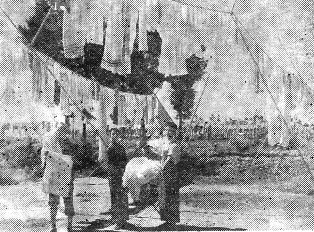 Laundrymen hang out the wash to dry, since the day is temporarily sunny. The front lines are towels; long rows of
khaki uniforms wave in the distance.
Laundrymen hang out the wash to dry, since the day is temporarily sunny. The front lines are towels; long rows of
khaki uniforms wave in the distance.
|
In China, where the average Stateside American believes the laundry center of the world exists, things are different. Practically every G.I. of Maj. Gen. C. L. Chennault's 14th A.F. has received at least one letter facetiously asking "...and try to locate that shirt our laundryman, Woo Lung, failed to return when he went back to China." There is only one answer. The proverbial Chinese laundrymen have all migrated to America. Those left here are all apprentices.
The soldier in China, where rains and mud prevail most of the year, sends out lots of laundry. This is necessary, in order for him to appear soldierly and clean. His laundry bag would make the average housewife scream and tear her hair. Over here, the returning laundry has the same effect on the G.I.
Get the picture? The Number One Boy, whose English is usually limited to "yesssir" and "hokay," picks up the laundry once a week. He takes it to his cohorts, the operators of the "Button Busters Laundry and Cleaning Co."
When a Flying Tiger of the 14th A.F. turns in his bag of laundry he has no illusions as to what he will get back. The mud will be gone, but in its place may be pastel streaks of green, vermillion and other colors. When he asks the Number One Boy "how come?" the answer is usually a bright "yesssir, hokay" accompanied by a toothsome grin.
Here we go. The laundry is first soaked in water which undoubtedly is drawn from the Yellow River.
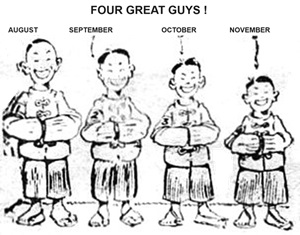
|
When it is reasonably luke-warm, the laundry is put into large metal pots. There is no separation of clothes. White underwear, khaki trousers, shorts and socks, neckties and caps go in with handkerchiefs, et al. Sometimes Al gets in, too.
Then the boys, after a time, remove the soaking wash. They twist it and wring it, all by hand, but that isn't enough. They take the poor defenseless laundry, lay it on the ground and then proceed to beat the hell out of it with flat sticks. Buttons? Who cares! Certainly not Number One, Two, Three or Four Boys.
The next move comes the same day or it may be several days later, because you can't hurry these lads. This is the hanging out of the wash.
Shades of Monday morning back home!
You think you have seen a line of wash? Out here they stretch for several city blocks. Each hostel has its own washing system, if you may call it that, and each hostel has its own clothes line. The boys, Numbers two, Three and Four (Number One stays inside - he's the boss) sling the baskets on bamboo poles, one on each end, and they get between them. Then, providing the day is reasonably sunny, they hang up the laundry. Line on line, waving in the breeze.
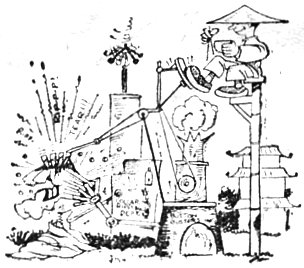
|
What happens next? It rains. Rains for at least three or four days. But the laundry stays right on the line. At least the rain water is clear.
The sun eventually comes out again. The clothes get fairly dry. Out march Numbers Two, Three and Four and collect the limpid looking laundry.
Then they press it. Creases mean nothing. They follow no precedent. They iron furiously away. Ironing boards? Never heard of them. They use tables, chairs and the floor. The razor edge crease you used to preserve so carefully when you sat down . . . it ain't there.
If you have insignia on your shirts and have been foolish enough to allow them to remain thereon when you threw them into the laundry bag, just consider them a total loss. The Flying Tigers, tough as they are in the air and in combat, are as helpless as baby lambs in the hands of Number One, Two, Three and Four. They literally tear the Tiger to shreds.
It might be well to add a word about the alleged dry cleaning of tropical worsteds, pinks and blouses. The Chinese idea of dry cleaning is to throw the worsteds, pinks and blouses into the same tub with the suntans. When they come out, dried and fantastically pressed, they would fit any member of the famed Singer Midget troupe.
And then, eventually, the laundry finds its way back to the soldier. How, nobody knows. Sure, you fill out a laundry slip, but they can't read it. You seldom lose any articles.
No tickee, no washee?
Hell... just plain no washee!
And you folks back home... you think you've got laundry troubles!
'SALLY' SUPER-FORT BELLE
SHE'S LOGGED MORE THAN 600 HOURS FLYING TIME
By HUGH A. CRUMPLER United Press Correspondent
20TH BOMBER COMMAND BASE, INDIA - "Sally," a languorous red-head who sometimes affects a peek-a-boo bob, is the belle of the 20th Bomber Command.
"Sally" isn't the pin-up type, although she might well be cast as Pluto's heartbeat if Mr. Disney should draw an Air Corps uniform on the bungling hound. The super-siren of the Super-Fortresses is exclusively a serviceman's gal.
And although she's only three years old, you'd hardly call "Sally" - a bob-tailed, flop-eared English cocker spaniel - a juvenile delinquent.
"Sally" was kidnapped in Australia two years ago by Lt. Col. Robert Clinkscales in one of the most scandalous affairs of its kind since the celebrated Helen of Troy - Paris incident. Since then, she has logged more than 600 hours flying time, including a bombing mission on Japan.
Clinkscales, hefty 27-year-old squadron leader, from Atlanta, acquired "Sally" by putting her in a veterinary hospital "for treatment" a few days before her original owner, Maj. James DuBose, of Augusta, flew back to the States from Australia.
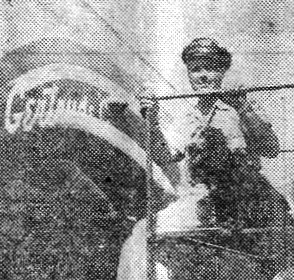
|
For the next five months, "Sally" was seen only in the best military circles of the Southwest Pacific Theater. She made eyes at Gen. Douglas MacArthur while Clinkscales flew him about the theater.
"She didn't get uppity, though," Clinkscales says. "Sally's a pretty level-headed woman."
Clinkscales and "Sally" flew back to the States last year and the colonel became a flying instructor at Orlando, Fla., Air Base. This was the low spot in "Sally's" career.
"It was all right when we were out at the base," the colonel recalls, "but 'Sally' just has a natural aversion to civilians. And women. Even women in uniform."
"Sally" languished but stuck it out until the two were assigned to the 20th Bomber Command. Now, happy again, she rides everywhere with Clinkscales in the pressurized cabin of his B-29, the Gertrude C.
She's never been airsick although she's flown The Hump, the rough India-China route over the Himalayas, seven times. "Sally" has a special oxygen box for emergencies. Her food is strictly G.I., chiefly C rations. And she's completely plane-broken.
But even her long association with the Air Corps hasn't overcome "Sally's" aversion to women. It's when Clinkscales says more than hello to a nurse that "Sally" fairly goes into a tissy. She cocks her head and one ear flops forward, achieving the popular hidden-eye coiffure.
"She's a jealous woman all right," Clinkscales admits. "When she goes to sleep, she always takes one of my shoes with her. I don't know what for, but I suspect she thinks that will keep me from leaving without her."
The final B-29 Yawata mission completed "Sally's" circuit of the globe. But, sophisticate that she is, she was bored with it all.
"Sally" was getting her beauty sleep.
Japs Execute Three U.S. Prisoners
WASHINGTON - (ANS) - Three more American prisoners of war have been executed by the Japanese, the Navy announced this week, in revealing the deaths of two Marine non-coms and a Navy seaman on July 31 of last year, following their escape from a prison camp. The Japanese Government had previously admitted the execution of captured American fliers from the April, 1942, Doolittle bombing of Tokyo and the first Super-Fort raid on Japan in June of this year.
According to information received by the Red Cross, said the Navy, the three, Seaman Frank Meringolo, Sgt. Joe B. Chastain and Cpl. Victor Papetti were captured and charged with killing a policeman five weeks after they had escaped from a prison camp in Manchuria. They were executed soon afterwards.
Runaway C-47 Chases Pick Off Airstrip
BURMA - Touring the forward areas, Brig. Gen. Lewis A. Pick, commanding general of thevLedo Road project, recently stopped and chatted with Pfc. Glenn Ballowe, of Chicago, operator of a road grader on the airstrip at Myitkyina.
"Dangerous business, operating engineering equipment under Jap fire," Pick remarked.
Ballowe's reply was a hoarse shout, "Look out, general!"
|
Pick whirled around and was confronted with a C-47 cargo plane, out of control, careening crazily off the landing strip into the area occupied by the general's personal plane and the road grader.
Pick and his executive officer, Col. C. S. Davis, and a score of officers and enlisted men suddenly found themselves in the path of the runaway ship. Rank and dignity were forgotten as everyone, to quote the general, "Got the hell out of there."
The C-47 crashed into the general's plane, crushing it like an egg shell, and caromed off on its path of destruction for another 50 yards, smashing against the grader where the general had been standing.
Still shaken after his close call, Pick was silent as he sadly surveyed the wreckage of his ship - a brand new, twin-engined plane, fresh from the manufacturer in the States. The shreds of the general's private seat in the plane, ripped to pieces by the propeller of the C-47, were more testimony of the narrow escape. For, had the accident occurred five minutes later, the general would have been seated in the plane, preparing to continue his tour.
And, as battle-grimed American infantrymen, Chinese soldiers and Chindits milled about the wreckage, Ballowe elbowed his way up to the general.
"Sir," he grinned, "flying is a dangerous business, too."
AIR CORPS AID LAUDED
By SGT. ARTHUR HEENAN Roundup Staff Writer
When Air Corps activity was at its height at Myitkyina Airstrip, one plane was landing or taking off every two minutes. This was, as Maj. Gen. George E. Stratemeyer pointed out, "a faster rate of traffic than LaGuardia Field."
The campaign for Myitkyina was the biggest show the Air Corps ever put on in the CBI Theater. The 10th A.F., ASC, Troop Carrier Command, Combat Cargo Group, Engineers and ATC all threw in their chips for the final pot that culminated in the fall of the communications hub of North Burma.
From terse compliments of Gen. Joseph W. Stilwell to British Pvt. Monson of Brig. Calvert's Chindit Brigade, who wanted "to buy the Mustang boys all the bloody beer they could drink," the Air Corps has been deluged with praise.
213 PLANES LOST
As one tired foot soldier commented, "Those Air Corps guys were trying to tell me they captured Myitkyina. I was there and I'm almost inclined to agree with them."
For the battered sons of Nippon, the visitations of the Yank airmen spelled constant death and destruction from the heavens, almost unhindered from the Japanese Air Force, which had been driven south by continued strafing and bombing of their fields. In air action, 213 enemy planes were destroyed during one 10-day period early in the campaign, a punishing body blow from which the Japs never recovered.
BANSHEES START
When Brig. Gen. Frank Merrill's Marauders and their Chindit comrades seized the Myitkyina Airstrip, May 17, P-40's of the Burma Banshees began operation from the field in the face of Japs entrenched at the other end.
As the days went by, B-25's continued their daily bombing of enemy dumps within the town, dive bombers blasted Jap strong points with pin-point precision, while B-24's deluged the Nip-held Myitkyina-Mandalay Railroad with spike bombs.
On the field, Col. Dan Callahan, of the Northern Air Service Area Command, took charge of the receiving end of what came to be known as "North Burma Airlines, Inc." From jumping off spots in India, Col. George Minor sent up supplies on a 24-hour basis.
Callahan and his veterans were responsible for the screening and monitoring of all supplies flowing into Myitkyina. As shot-up planes limped in, they were serviced by a group of hard-boiled ASC G.I.'s under Col. Andrew J. Castleman, who had seen action in the Middle East and Italy.
These men earned nine Purple Hearts before being relieved. They were commended by Maj. Gen. Thomas J. Hanley who took to a slit trench his first day on the scene as anti-personnel bombs were dropped by the Nips. Reclining in the same ditch with Hanley were Brig. Gen. James W. Spry and Callahan.
MORARITY WITNESS
Maj. Thomas H. Morarity, public relations director of ASC, was an eye-witness of the airstrip melee and described the Castleman group, who worked through Jap strafing and bombing as "a task force of airplane repair, salvage, communications and fire power."
Castleman's outfit was later relieved by a unit under Col. William J. Pocock.
Airborne Engineers continually worked on the field under command of Col. M. J. Ascensio. Other Engineers from ASC later were moved in under Brig. Gen. Stuart Godfrey.
The Troop Carrier Command pilots of Brig. Gen. Barney Old, who had personally piloted in the first air-towed glider to the airstrip, had one of the most grueling jobs at Myitkyina. Time and again they brought their unarmed transports in amidst Jap ack-ack and Zeros.
That was one of the nice things about Myitkyina. The pilots had to circle over Jap positions before setting their craft down. There was never a dull moment until the Ground Forces took the town and found that the Yank bombardment, mostly from the air, had shattered every house from cellar to roof.
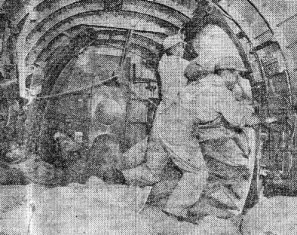
|

|
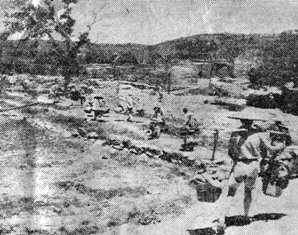
|
In the bitter fighting along the Salween River Front, Chinese ground troops are often in isolated positions impossible to supply by road network. Fourteenth Air Force Troop Carrier Squadron planes make daily flight, dropping much-needed food, supplies and ammunition. The above photographs depict a mission in the Kaoli Mountain Range, the world's highest, toughest battleground. At left, T/5 John F. Kasperzyk, Pvt. Allen F. Lentz and Pvt. John Klimasara drop rice-laden 'chutes over the "target." next, the 'chutes billow in the wind to the troops below. And, finally, Chinese soldiers carry the literal "manna from heaven" to their comrades through the ruins of a village.
Black Widow Plane Mightiest In Air
WASHINGTON (ANS) - Details of "the world's largest and most powerful pursuit plane," the P-61 Black Widow, were revealed this week by the Northrop Aircraft Company.
The Black Widow, designed especially for night fighting, has been described by its makers as "capable of shooting down anything that flies." It is protected from 30 and 50 caliber bullets by new and secret armor plates, resistant glass and deflectors. With a full-span landing flap, which gives the plane a low landing speed, combined with a new type aileron, the Black Widow has unusual maneuverability.
The P-61's top speed and altitude ceiling are still closely-guarded secrets.
 Four generals interrogate the crew of a B-29 following the raid on Anshan, Manchuria. From left to right, Brig. Gen.
Otto L. Nelson, executive to the Deputy Chief of Staff of U.S. Army; Maj. Gen. Clayton Bissell, head of G-2 and formerly
commanding officer of the 10th A.F.; Lt. Gen. Barney M. Giles, Chief of the Air Staff, and Brig. Gen. Laverne Saunders
of the 20th Bomber Command. These officers are on a world tour of the battle fronts and all are from outside the Theater
except Saunders.
Four generals interrogate the crew of a B-29 following the raid on Anshan, Manchuria. From left to right, Brig. Gen.
Otto L. Nelson, executive to the Deputy Chief of Staff of U.S. Army; Maj. Gen. Clayton Bissell, head of G-2 and formerly
commanding officer of the 10th A.F.; Lt. Gen. Barney M. Giles, Chief of the Air Staff, and Brig. Gen. Laverne Saunders
of the 20th Bomber Command. These officers are on a world tour of the battle fronts and all are from outside the Theater
except Saunders.
|
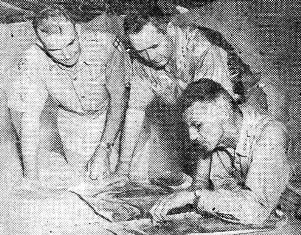 Gen. Joseph W. Stilwell, commanding general of the USAF in CBI, explained last-minute battle plans to Maj. Gen. Howard
Davidson, left, head of the 10th A.F. and Gen. Giles, center. This scene was taken in Uncle Joe's tent near Myitkyina
before the fall of this Jap communication center in North Burma on August 3. Stilwell sent in Chinese units for the final
assault, with daily bombings by Davidson's airmen of the CBI based 10th A.F. Various other air units also aided the
campaign.
Gen. Joseph W. Stilwell, commanding general of the USAF in CBI, explained last-minute battle plans to Maj. Gen. Howard
Davidson, left, head of the 10th A.F. and Gen. Giles, center. This scene was taken in Uncle Joe's tent near Myitkyina
before the fall of this Jap communication center in North Burma on August 3. Stilwell sent in Chinese units for the final
assault, with daily bombings by Davidson's airmen of the CBI based 10th A.F. Various other air units also aided the
campaign.
|
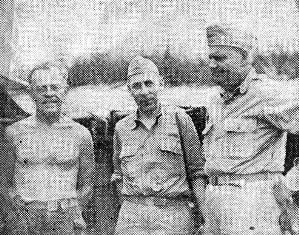 Between operations, Lt. Col. Gordon Seagrave poses for a picture with Gen. Bissell, center, and Maj. Gen. Wilhelm D.
Styer, Chief of Staff of the Army Service Forces. This scene was taken at the hospital just a few hundred yards from
the Jap battle lines at Myitkyina. Seagrave, noted as the "Burma Surgeon" was on the famous retreat from Burma with
Uncle Joe and has served with him since. He still has his well known Burma nurses some of whom "walked out" of Burma
with him in 1942.
Between operations, Lt. Col. Gordon Seagrave poses for a picture with Gen. Bissell, center, and Maj. Gen. Wilhelm D.
Styer, Chief of Staff of the Army Service Forces. This scene was taken at the hospital just a few hundred yards from
the Jap battle lines at Myitkyina. Seagrave, noted as the "Burma Surgeon" was on the famous retreat from Burma with
Uncle Joe and has served with him since. He still has his well known Burma nurses some of whom "walked out" of Burma
with him in 1942.
|
Shattered Forever.... Childhood Illusion
By JACK GUINN United Press Correspondent
WITH AN AMERICAN LIAISON UNIT, NORTH BURMA - The gods of war are all iconoclasts, and now they have destroyed forever one of the fondest dreams of my childhood, and shattered an abiding faith in the moral and physical strength of elephants.
I went home after my first circus and immediately launched into attractive dreams of myself sitting in a brocaded box atop a huge elephant, swaying along in resplendent comfort, confident that my elephant could walk over
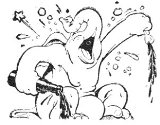
|
But these dreams are gone now, and have been since AP correspondent William Boni and I rode an elephant across about 10 miles of Burma mud and were almost drowned when the great beast walked off into a river about five feet deeper than he was tall.
Added to that was the disillusioning discovery that elephants are depraved creatures, addicted to vice, and know as much about clean living as the Bobbsey Twins knew about roulette.
Specifically, they're candidates for a WCTU campaign. They're drunkards.
Take the word of Capt. Emanuel Bomese, of Brooklyn. "I saw a Kachin give a half pint of lique (a fiery intoxicant distilled from rice) to an elephant one morning," Bomese said.
"The elephant drank it, eased down to his knees and then rolled over with a great sigh - and wouldn't get up for three hours."
Bomese said that the Kachins give lique to elephants all the time. The elephants like it, probably enjoying, like anybody else, a few hours unconsciousness.
The elephant we rode 10 miles down a muddy trail must have had a hangover. I had always marveled at the circus at the slow, determined way of an elephant, the positive manner he has of walking as if he could step on an egg and stop his foot before the shell cracked. The elephant wouldn't know if it he walked off into Grand Canyon.
He stumbled and staggered down the trail, almost falling several times. Boni and I clutched the frail bamboo basket, loosely tied on with a piece of rope, in which we were riding in considerable discomfort, and wondered how hard we would hit the ground by falling from a nine-foot-tall elephant.
We sloshed by all the refuse of war which had not been worth the time of souvenir collectors. Japanese gas masks with the eye pieces shot out lay staring up in the rain like a Dali drawing of a nauseated world. Broken cases of Japanese ammunition lay spilled across the trail and every now and then we would pass near an unburied Jap or a horse or a mule that had fallen in the trail and had been left to rot. Then we would be struck by the sickening mingling of the hog-pen stench of rotting vegetation in the mud and the terrible smell of the too long unburied.
Once we saw a swarm of beautiful butterflies, circling like a funeral wreath over the puffed gray body of a dead mule.
In our precarious perch atop the elephant we were sitting on two Army field packs, with our raincoats spread out over our heads and equipment to keep out a little of the rain. We had placed all our valuables in our shirt pockets, thinking that no matter how deep the water, it wouldn't be that deep - not on top of a nine-foot elephant.
The Burmese driver-owner sat on the elephant's head and urged the beast along by beating it on the skull with a long knife and shouting what must have been curses into its big flapping ears. He screamed "ting hao," which in Chinese means something like "very good" and which apparently was the Burman's entire Chinese vocabulary, at each passing Chinese soldier. When he wasn't addressing his elephant or Chinese soldiers he was grinning back at us and hollering "OK Joe, mercan sigreet." American cigarettes will buy anything in Burma. Anything.
Then we walked off into this stream. It was a little stream, but it was rushing away with waters from the monsoon. The elephant walked right in. The current hit him and the next few seconds were blurred in splashing water. The elephant's head, except for the tip of the trunk, and the Burmese driver went completely under. Then the cold, muddy water hit our knees, our backs, up past our shirt pockets and finally up to our necks. A couple of more splashes and we were out, the elephant stumbling and slipping up the other bank.
The Burman hit the elephant a lick with the knife and looked around at us and grinned.
"Ting hao," he said.
"Ting hao yourself, you bastard," we said.
"OK Joe, mercan sigreet," he said.
The mercan sigreets were all soaked.
JEEP RAILWAY LINE IN NORTHERN BURMA
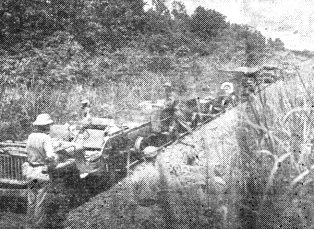 General view of jeep train, carrying supplies from Myitkyina to Mogaung.
General view of jeep train, carrying supplies from Myitkyina to Mogaung.
|
NORTH BURMA - It's a long, rough road, from Myitkyina to Mogaung, as anyone who has ever been there will tell you. But until recently, it wasn't generally known that G.I.'s, both American and Chinese, were negotiating the 31 miles in true Casey Jones fashion, via the jeep-powered Lightning Express.
Until the fall of Myitkyina, the existence of the Lightning Express and the improved railway had been military secrets.
The narrow-gauge line, captured bit by bit from the Japs, runs from Mogaung almost to the Myitkyina Airfield. On the front end of the train is one each jeep. On the rear end, facing backward or caboose-wise, is another one each jeep. In between are three flat cars. On the flat cars are men, equipment, and, occasionally, such miscellany as war correspondents.
On the up trip, the front-end jeep does the tugging. On the down trip, the front-end locomotive becomes the caboose. Reason: There ain't no place to turn the train around.
The first run of the bale-wire cannonball (average speed: 25-35 MPH) was made by Capt. James H. Kaminer, of Lexington, S.C., Engineer officer, accompanied by two American G.I.'s, a British brigadier and a major.
American Engineers even now are plotting to replace the present equipment with heavier, more powerful units, and will use captured diesel engines to do the towing.
Lt. Benjamin H. Lester says that every trick of the trade is being used to prepare the road for the heavier trains. Engineers are shoring up or reinforcing piers and abutments with all available materials. Burmese and Indian trackmen are surfacing and lining track and filling in bomb craters.
Pvt. Wilbur E. Childers, the present jeep driver, made this notation on a trip record: "Sort of a thrill. Used to drive a cab. These jeeps do everything but fly."
Cpl. John R. Thomason, who has earned the title of trainmaster, serves with a former neighbor and civilian buddy, Cpl. Angele LeGreca, neither of whom expected to wind up on a G.I. railway in Burma.
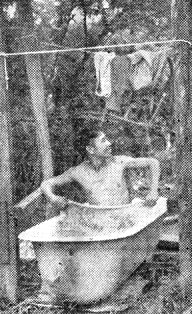 A Chinese soldier of the 38th Division takes advantage of the rare luxury of the only enameled bathtub in Mogaung.
A Chinese soldier of the 38th Division takes advantage of the rare luxury of the only enameled bathtub in Mogaung.
|
Chinese Reduce Strong Points At Tengchung
Tengchung promises to be a second Myitkyina as far as stubbornness of resistance is concerned, with the Jap garrison defending strong points in the city and making sallies to drive the Chinese 20th Army troops back from the city walls, say dispatches from headquarters of Brig. Gen. Frank Dorn this week.
In one night this week, the Japs made seven savage counter-attacks which were repelled with heavy loss by the Chinese. When the attacks had ceased, over 60 enemy bodies were counted on the walls and over 200 were in a trench in the narrow no-man's land before the walls.
SLOW WORK
The Chinese are still attacking the enemy, systematically destroying their individual strong points. It is slow, tedious work, aided by 14th A.F. bombers, who are hitting the Jap positions daily.
The Chinese are also attacking at other sectors along the front. At Sungshan, the Chinese are digging approach trenches towards the summit of the mountain preparatory to making assaults on two heavily fortified Nip positions.
ACK-ACK FIRE
Satellite positions of the Japs on peaks adjacent to Sungshan Peak have been wiped out. Attacks on Sungshan are being supported by artillery, with one battery of American anti-aircraft firing in a horizontal direction, although designed for vertical fire. These weapons are also used against enemy aircraft, one of which has fallen victim to the battery.
Nip Supply Line Major Target Of EAC Pilots
10TH A.F. HQ. - Japanese lines of communication, including railroads, river and land routes, provided the principal targets this week for the Tactical, Strategic and 10th Air Forces of Maj. Gen. George E. Stratemeyer's Eastern Air Command.
Throughout the period, the northern sector of the Mandalay-Myitkyina railroad was heavily attacked
 Army Mail Clerks are no dopes. They selected Jean parker as their "P.O. Girl" Who wouldn't play Post Office?
Army Mail Clerks are no dopes. They selected Jean parker as their "P.O. Girl" Who wouldn't play Post Office?
|
BRIDGES HIT
In addition to inflicting severe damage to railroad tracks, stations and yards, the dive-bombers and mediums knocked out a number of key bridges.
Mitchells attached to Sir John Baldwin's Tactical Air Force bombed the Tiddim Road on several occasions, and also attacked various objectives along the Chindwin River. A number of large river craft at Sittaung were destroyed or damaged. Dive-bombers and fighters were also active in the Tiddim area.
CENTRAL BURMA
Throughout the week, long range fighter-bombers and dive-bombers kept up their attacks against Japanese lines of communication in Central Burma.
Wellingtons and Liberators of the Strategic Air Force flew successful missions against Pinlebu, Indaw and Thityabin.
Chinese Return To Hengyang
CHINA - Counter-attacks have brought stubborn Chinese troops once more within sight of Hengyang, walled city in Hunan Province on the Canton-Hankow Railway, after its capture by the Japanese.
Chinese vanguards were reported within three miles north and west of the city early this week, another had reached a point 11 miles to the southeast, and one from the south was eight miles away.
The city fell after nearly two months of fierce fighting. The night before it capitulated, the high command at Chungking received a message from the Chinese commander at Hengyang which declared that his soldiers were killed "virtually to the last man."
"I am afraid this may be my last message to you," he wrote.
14TH A.F. TURNS BACK ENEMY AIR THRUST
14TH A.F. HQ. - Crack fighter pilots of the 14th Air Force this week smashed another bid by Japanese air power to halt the widespread raiding of roads, rivers and sea lanes by Maj. Gen. Claire L. Chennault's flyers. Fifty-four Jap planes were destroyed in the air or aground, 14 more were probably destroyed and 43 damaged in a series of air battles and airdrome attacks which cost the 14th only five planes. Master stroke was a sweep over Taiyuan airfield, Jap training center northeast of the Yellow River bend, in which two fighters were shot out of the air, 21 fighters and three transports destroyed on the ground, and an additional 24 grounded planes damaged.
HARASS HENGYANG
U.S. and Chinese-American Composite Wing Warhawks and Mustangs continued to harass Jap ground forces around Hengyang, meeting strong air opposition. In one day, they destroyed 140 trucks and damaged 24 at Kweiyi, while a few days later 65 vehicles were destroyed or damaged near Hengyang. River craft, supply dumps, troop assembly points and gun positions were also hit in the battle area.
Battered enemy supply columns began moving by night, but 14th Air Force planes, flying after dark missions, continued to pound them. Airfields at Hankow, Pailuchi, Amoy and Siangyin were also attacked in this period.
HIT SHANGHAI
Liberators struck the first U.S. bomber blow at Shanghai harbor, and scored direct hits on the camouflaged S.S. Conte Verdi, former Italian luxury liner now in Jap hands. Another B-24 raid, on Changsha, caused 22 large explosions and fires from which smoke rose 8,000 feet.
On the Salween front, B-25's, P-38's and P-40's repeatedly bombed the walls of Tengchung, besieged by Chinese ground forces, and also attacked Lungling, Mangshih and Chefang.
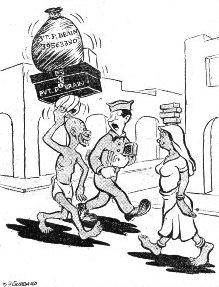
|
SAVED FROM CAPTURE
By Convincing Drunk Act
By JACK GUINN United Press Correspondent
A FORWARD U.S. COMBAT MEDICAL UNIT, NORTH BURMA - Narrow escapes from death at the hands of the Japanese are no rare occurrence in this part of the world, but Capt. William O. Goode, of Lake City, Colo., says that his medical unit is the only one in Burma that was ever saved from possible ambush by drunkenness.
Goode was in command of a medical unit which followed one flank of Gen. Joseph W. Stilwell's Sino-American army down the Mogaung Valley. On one occasion, Goode led his men up a jungle trail that led through a Kachin village. He stopped outside the little town of huts to decide whether to go around the village or to risk sending someone in to find out if the Japanese were about.
Finally, he sent in a Kachin mule sergeant named "Pop," a wily old character. "Pop" went into the village and stopped at a bamboo hut to make inquiries. There he encountered a British doctor whom Goode remembers only as being named Rosenthal.
Almost at that moment, a villager slipped in through the rear of the hut and informed them that a group of Japanese officers was approaching.
"Pop" immediately grabbed a bamboo flask of Kachin "lique" and sat on the floor. Rosenthal followed his example. "Pop" took a big drink of the fiery liquid and immediately began to laugh drunkenly. Rosenthal had a drink, roared with laughter.
Within a few minutes a Jap officer, two-handed saber ready for action, was standing in the door of the hut, demanding to know what was going on.
Rosenthal rose drunkenly to his feet, declared in Japanese that he was a German army officer, heil Hitler, observing the war, and that at the moment he was having a party. He asked the Jap to sit down and have a drink. The Jap brought in his four friends and sat down.
In a relatively short time, Kachin liquor being what it is, the Japs were so drunk they couldn't count their ancestors and "Pop" and Rosenthal quietly slipped away.
The C.B.I. Roundup is a weekly newspaper of the United States Army Forces, published by and for the men in China, Burma, and India, from news and pictures supplied by staff members, soldier correspondents, United Press, OWI, and Army News Service. The Roundup is published Thursday of each week and is printed by The Statesman in New Delhi India. Editorial matter should be sent directly to Capt. Floyd Walter, Headquarters., U.S.A.F., C.B.I., New Delhi, and should arrive not later than Sunday in order to be included in that week's issue. Pictures must arrive by Saturday and must be negatives or enlargements. Stories should contain full name and organization of sender.

AUGUST 17, 1944
Original issue of C.B.I. Roundup shared by Ruth Canney, widow of CBI veteran John Canney.
Copyright © 2006 Carl Warren Weidenburner
TOP OF PAGE PRINT THIS PAGE ABOUT THIS PAGE SEND COMMENTS
PREVIOUS ISSUE CLOSE THIS WINDOW NEXT ISSUE
 Brig. Gen. Lewis Pick, left, and his executive officer, Col. C. S. Davis, talk to Pfc. Glenn Ballowe, operator of a road grader on the Myitkyina Airstrip. Shortly after, a runaway C-47 destroyed the general's new private plane.
Brig. Gen. Lewis Pick, left, and his executive officer, Col. C. S. Davis, talk to Pfc. Glenn Ballowe, operator of a road grader on the Myitkyina Airstrip. Shortly after, a runaway C-47 destroyed the general's new private plane.